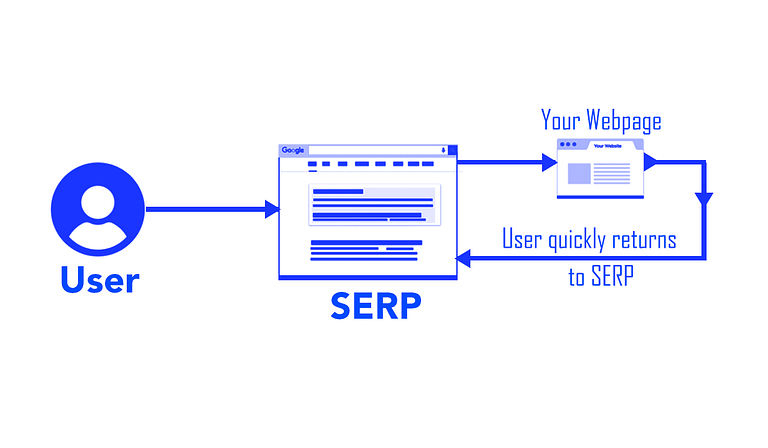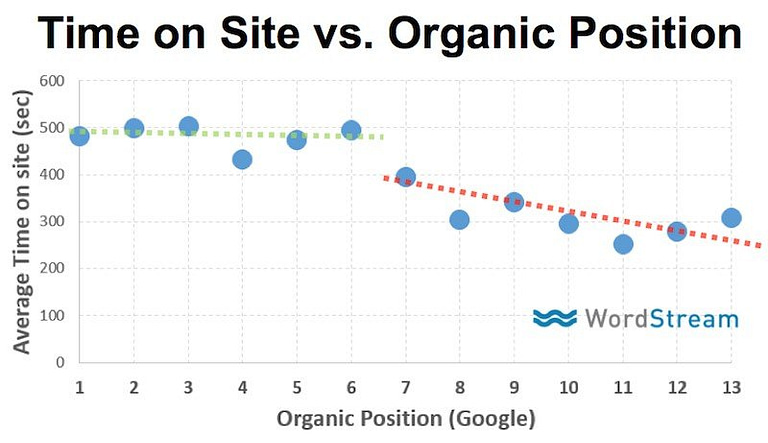Dwell Time
<< Measure SEO
Organic CTR >>
What is Dwell Time in SEO?
Dwell Time is the time a user spends on a webpage from the search results page before returning to the SERP.
Dwell Time always starts and ends with SERP.
Let me explain with an example:
Say you search for a Chinese restaurant in Gurgaon.
You click on the first result (not an ad) in the SERP. That click takes you to a webpage. Now you spend Time exploring the page – let’s say you go through the Menu section, Location, etc. You decide to return to the SERP after spending 2 minutes 20 seconds on that page. That’s what is Dwell Time for the page you have just visited.

Dwell Time vs. Bounce Rate vs. Time on Page
Dwell Time: as mentioned above, the length of time a user spends looking at a site after selecting the link from a SERP before going back to the SERP.
Time on Page: It refers to the Time a user spends on a page before navigating anywhere else. This includes the user going to another page on your website, an external link in your content, or even to the SERPs.
It’s calculated based on two clicks – the click brings the person to the webpage mentioned in the question, and the click takes the person away from the site.
Bounce rate: This means when a user leaves your webpage without clicking anywhere on the page. This is a single-page session.
The bounce can result from a person going back to the SERPs or closing the page.
Whether they spend half a second or 2 hours on the page, it will still qualify as a bounce rate.
Now, if the time on the page is low, it might mean that the user got the answer they needed quickly and, consequently, left the website soon.
The same holds of the bounce rate: After a quick review, the user can get the details he needed and close the window.
Now I should point out one thing here:
Dwell Time and Bounce Rate might sound similar. But they’re not the same thing.
Because Bounce Rate doesn’t tell you whether the searcher was satisfied with a specific result, Dwell Time does.
It doesn’t matter if a person has spent 1 second or 1 hour on the page. If the user clicks back on the result, it’s a bounce. But Dwell Time tells you the entire story.
Why is Dwell Time important?
In 2011, Duane Forrester (a Senior Project Manager for Bing at that Time) mentioned Dwell Time in his post.
He almost confirmed that Bing considers Dwell Time in its algorithm.
Now the big question is, does Google consider Dwell Time a ranking signal?
Google has never published a formal statement on how and Dwell time factors in a ranking.
Having said that, there have been hints that it’s a consideration.
In 2017, Nick Frost, chief of Google Brain, was quoted as telling:
“Google is now integrating machine learning into [the process of figuring out what the relationship between a search and the best page for that search is]. So then training models on when someone clicks on a page and stays on that page, when they go back, or when they are trying to figure out exactly that relationship.”
Also, a few years ago, Google launched a new feature that lets you hide a particular website from the SERPs.
How did Google know which sites you wanted to hide?
If you quickly bounced from that page, it would prompt you to block that entire website.
Another important study on Moz found there’s a clear correlation between Dwell Time and Organic Position.

It shows if your keyword/content pairs have a decent amount of time on-site, then the probability for your site to be in top organic positions 1-6 is higher.
If engagement is weak, then you’ll likely find your site in position 7 or below.
Best Practices to Improve Dwell Time
Produce readable, scannable, and longer content
That’s obvious. The longer the content is, the longer people will stay on your page.
It takes much longer time to read a 2000 words blog than just 300 words long.
Of course, you will not just fluff it with some random content; it must be engaging enough to keep the audience glued to your page.
It would be best if you structured it strategically.
In my case, I start with the preview:
The visitor will know what the content is exactly about and what he will get out of it.
I include proof – how it can help the readers.
Finally, set the tone right and begin the action.
Create skimmable content. Most people don’t read it line by line; they skim through.
So, break large paragraphs into small ones.
Embed Videos
According to one survey, 80% of marketers say video has increased dwell time on their site.
There are multiple ways you can embed a video in your content.
You can use a video at the place of text.
Or, instead of linking to a blog post, you can link to a video.
Internal Linking
Internal links help to keep users on the website for longer.
I use internal linking to feature other content people might want to read.
After linking to this page, I noticed that the number of visitors jumping from the page had gone up.
Engage with Comments
A Google employee in a Twitter chat once said that “Healthy, thriving community on a site can help a lot” with rankings.
Is community a direct signal?
Or is it an indirect ranking signal?
Google hasn’t said anything publicly in that regard.
But community can certainly help to increase the Dwell Time.
Firstly, It people commenting on the site will end up spending extra time on the site and
Secondly, people like reading comments. Sometimes they also get many solutions from just reading the comment section.
Load time
Load time is how much time it takes for your webpage to load.
According to industry data, if your website loads in 4 seconds or more – then you have work to do.
People don’t wait for that long. They are looking for instant solutions.
So, there’s no alternative to that instead of loading your page as faster as possible.
Google takes it so seriously that they introduced Core Web Vitals to enhance the page loading speed for the users.
You can use an excellent tool from Google – Google Website Speed Test.
Head over the tool and insert your website – it will show you speed reports and fixes in a minute.
Mobile Friendliness
The majority of the users visit a website through mobile phones.
Hence, the mobile version of your site is even more important than the desktop version.
To check your site’s mobile friendliness – head over to the search console.
Then click on “Mobile usability” under “Enhancements.”
And you will know which pages have a bad user experience.
Search Console will give details about the problems and suggest you possible fixes.
Browsers Friendliness
I have seen a lot of features that might not be compatible all across the browsers.
For example:
Your website layout might look differently than expected in some browsers.
Make sure you test your website across all the major browsers: Chrome, Safari, Firefox, and Opera.
How to calculate Dwell Time
There’s no “Dwell TIme” report in Google Analytics or Search Console.
However, Google Analytics reports you “Average Session Duration.”
Average Session Duration means how much time a user spends on your website after landing on that page, which is pretty close to Dwell time.
Let’s see how to check it for your site:
First, log in to Google Analytics.
And Click on “Behaviour” > “Site Content” > “Landing Pages.”
Then set up a segment and specify that you want only to view “Organic Traffic.”
Then you will find the “Average Session Duration.”
How to use this information?
I’d say, first observe the pages with high “Average Session Duration.”
And apply the same formula to other pages that have low “Average Session Duration.”
I checked the details on the page, and I figured out:
You can also improve the pages with low Dwell Time.
For example,
So, what’s a good Dwell Time?
One line answer: it depends.
Long answer:
Let me take an example to explain:
If you operate a weather site, users may need 2 minutes to get what they want. In that event, your Dwell Time will naturally be on the lower side.
On the other side, blogs and videos can expect a higher Dwell Times because it takes a good time to read articles and watch videos.
So, start compiling all the details related to Dwell Time to find an ideal Dwell Time for your site. That can include:
- Your site niche
- The type of content
- Search query users use to find your page
- Any Seasonal trends
- And more
With that, you can improve your website Dwell Time using the strategies you have learned in this lesson.
Previous
Next
Organic CTR >>

